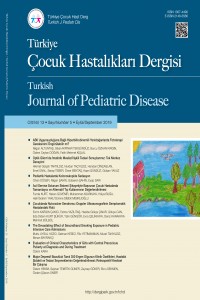Abstract
Amaç: Optik gliomlar histolojik olarak benign özelliklidirler ve iyi yönde farklılaşma gösteren pilositik astrositom sınıfında yer alırlar. Tümörün histopatolojik özelliği, yerleşim yeri, hastanın yaşı, Nörofibromatozis tip-1 ile birlikteliği sağkalım oranlarını etkileyen önemli prognostik belirteçlerdir. Kemoterapi tedavide en önemli seçenektir ve klinisyenlerin hedefi radyoterapiden olabildiğince uzak durmaktır. Radyoterapi ve cerrahiden uzak kalınmasına zemin hazırlayan, uzun döneme yayılan güvenli bir tedavi planı olan vinkristin ve karboplatin kombinasyonu ilk seçenek standart tedavi yaklaşımlarından biridir. Ancak bu tedaviler altında refrakter seyreden hastalara sistemik yan etkisi az ve bir multi tirozin kinaz inhibitörü olan imatinib mesilat önemli bir seçenek olarak eklenebilir. Çocuk hastalarda güvenli bir şekilde kullanılabilir. Bu alanda bildirilmiş az sayıda çalışma olması nedeni ile imatinib mesilat kullanımına ait olumlu sonuçlarımızı klinisyenlerle paylaşmak istedik.
Gereç ve Yöntemler: Çocuk Onkoloji kliniğimizde 2007-2017 yılları arasında tanı alan toplam 16 optik gliom hastası çalışmaya dahil edildi.
Bulgular: İki kür vinkristin, karboplatin kombinasyonu sonrası klinik ve radyolojik olarak progresif seyreden hastalara stabil hastalık veya regresyon bulguları elde edilene kadar 1-2 yıl süre ile imatinib (270 mg/m² oral) tedavisi eklenildi. Tedavi alan hastaların median izlem süresi 7 yıl (5-10)’di. Dört hastada tam yanıt, iki hastada stabil hastalık bulguları sağlanıldı. Hastalarımızda imatinib ilişkili bir yan etki görülmedi.
Sonuç: İmatinib tümörün kapiller endotellerinden özellikle PDGFR- α ve β’nın ekspresyonunu inhibe ederek etki eder. Akıllı hedef moleküllerin tedaviye eklenilmesinin progresif hastalarda geç dönemde yan etkileri fazla olan radyoterapiye olan ihtiyacı azaltacağını düşünüyoruz. Gelecekte uygulanabilecek birçok moleküler hedef ajan refrakter optik gliomların tedavisinde gündeme gelebilir ve çocuk hastalar cerrahi ve radyoterapinin yaratacağı komplikasyonlardan korunabilirler.
Keywords
References
- 1. Thomas RP, Gibbs IC, Xu LW, Recht L. Treatment options for optic pathway gliomas. Curr Treat Options Neurol 2015;17: 333.
- 2. Louis DN, Perry A, Reifenberger G, von Deimling A, Figarella- Branger D, Cavenee WK, et al. The 2016 World Health Organization Classification of Tumors of the Central Nervous System: A summary. Acta Neuropathol 2016;131: 803–20.
- 3. Binning MJ, Liu JK, Kestle JR, Brockmeyer DL, Walker ML. Optic pathway gliomas: A review. Neurosurg Focus 2007;23: E2.
- 4. Rasool N, Odel JG, Kazim M. Optic pathway glioma of childhood. Curr Opin Ophthalmol 2017;28:289-95.
- 5. Goodden JMC. Optic pathway hypothalamic glioma. In: Winn HR (ed). Youmans and Winn Neurological Surgery. 7th ed. Philadelphia: Elsevier, 2016:1660-7.
Abstract
References
- 1. Thomas RP, Gibbs IC, Xu LW, Recht L. Treatment options for optic pathway gliomas. Curr Treat Options Neurol 2015;17: 333.
- 2. Louis DN, Perry A, Reifenberger G, von Deimling A, Figarella- Branger D, Cavenee WK, et al. The 2016 World Health Organization Classification of Tumors of the Central Nervous System: A summary. Acta Neuropathol 2016;131: 803–20.
- 3. Binning MJ, Liu JK, Kestle JR, Brockmeyer DL, Walker ML. Optic pathway gliomas: A review. Neurosurg Focus 2007;23: E2.
- 4. Rasool N, Odel JG, Kazim M. Optic pathway glioma of childhood. Curr Opin Ophthalmol 2017;28:289-95.
- 5. Goodden JMC. Optic pathway hypothalamic glioma. In: Winn HR (ed). Youmans and Winn Neurological Surgery. 7th ed. Philadelphia: Elsevier, 2016:1660-7.
Details
| Primary Language | Turkish |
|---|---|
| Subjects | Internal Diseases |
| Journal Section | ORIGINAL ARTICLES |
| Authors | |
| Publication Date | September 23, 2019 |
| Submission Date | May 21, 2018 |
| Published in Issue | Year 2019 Volume: 13 Issue: 5 |
Cite
The publication language of Turkish Journal of Pediatric Disease is English.
Manuscripts submitted to the Turkish Journal of Pediatric Disease will go through a double-blind peer-review process. Each submission will be reviewed by at least two external, independent peer reviewers who are experts in the field, in order to ensure an unbiased evaluation process. The editorial board will invite an external and independent editor to manage the evaluation processes of manuscripts submitted by editors or by the editorial board members of the journal. The Editor in Chief is the final authority in the decision-making process for all submissions. Articles accepted for publication in the Turkish Journal of Pediatrics are put in the order of publication taking into account the acceptance dates. If the articles sent to the reviewers for evaluation are assessed as a senior for publication by the reviewers, the section editor and the editor considering all aspects (originality, high scientific quality and citation potential), it receives publication priority in addition to the articles assigned for the next issue.
The aim of the Turkish Journal of Pediatrics is to publish high-quality original research articles that will contribute to the international literature in the field of general pediatric health and diseases and its sub-branches. It also publishes editorial opinions, letters to the editor, reviews, case reports, book reviews, comments on previously published articles, meeting and conference proceedings, announcements, and biography. In addition to the field of child health and diseases, the journal also includes articles prepared in fields such as surgery, dentistry, public health, nutrition and dietetics, social services, human genetics, basic sciences, psychology, psychiatry, educational sciences, sociology and nursing, provided that they are related to this field. can be published.


